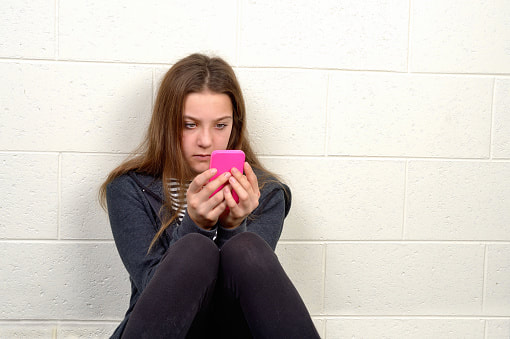Boundaries In a world of Tik Tok and Instagram teens are more distracted and occupied with all sorts of
Social Media and access to the what technology has to offer. This in turn, making parenting an even greater challenge. The teen years are a significant period of growth and identity development. Setting boundaries is an essential function to help them develop their own beliefs, values and a sense of self. Teens need boundaries to help them develop self-respect, confidence, judgment, responsibility and appropriate decision-making skills. According to Psychologist E. Erickson’s stages of development, adolescence/teens need to develop a sense of self and personal identity. When they succeed, it leads to an ability to stay true to themselves while failure leads to role confusion and weak sense of self. They need to learn to cope with social and academic demands. When they succeed, it leads to competence while failure leads to inferiority. Rules help and keep teens headed in the right direction. Rules need to be based on the boundaries set at home. Boundaries aren’t the rules, they are the fence posts placed around behaviors. They are the delineation of how a family’s beliefs are to be lived out. Boundaries define what a teen will and won’t accept and should come from what a parent believes is right for the teen at this stage in their life. Parents can feel empowered by a Social media support to help take on the challenge of parenting and boundary setting as they are also equipped with tools social media has to offer. As New York Times best-selling author, mother, podcast host, and “That Boundary Lady on Instagram,” Melissa Urban offers her latest gift to parents in her book, The Book of Boundaries. Melissa points out in her book that, “boundaries mark the limits of behavior that are acceptable to you, where words or actions beyond that limit cause you harm or make you feel unsafe. Boundaries are not used to tell your teen what they can and cannot do, as that would be controlling. Boundaries are established to help you plan and communicate your response to what your teen says or does. Boundaries are the action steps to help us keep the world and our home safe, for ourselves and our teens. When parents set boundaries they set a tone of what behaviors will and will not be accepted in order to grow and nurture the parent child relationship. Melissa teaches step by step language in HOW to set and keep boundaries an area that parents tend to struggle with. Setting the boundary might come easier than following though with holding the boundary. Here’s a brief how to guide…. Step one: Set the boundary using clear and kind language. There are three levels of boundaries using the analogy of a traffic light. “Green is the gentlest, kindest language. You are assuming that the person (teen) didn’t know you had a limit and wants to be respectful and healthy in your relationship. You’ll share this green language and see where it goes. Yellow is okay, this person/teen is either forgetting or unwilling or reluctant to respect my boundary, now my language needs to be a bit more direct. It’s still kind, but it’s more direct and impactful. I may share a consequence here, like if we can’t change the tone of this discussion, then I’ll be leaving the room for five minutes so we can take a break. The red level boundary is if the behavior continues to escalate, this is the boundary, this is the consequence, this is the action that I am going to take to keep myself safe and healthy, which is I’m going to interrupt you. The way you are speaking to me right now does not feel okay to me. I’m going to leave for an hour and when I come back we can resume. That’s your red.” Hold the boundary. Boundaries can be difficult but Melissa’s script format offers a conversation with ease. Parenting is challenging enough, setting boundaries although initially can be a dread, doesn’t have to be. Sharon Volner, LMFT #47484 La Ventana
0 Comments
Social Media and Teens – (from article, Our Kids in Crisis, by Stephen Perrine NYT)
According to a CDC report in October 2021 From 2010 and 2020 suicide rates among teens had risen 53%. Then came the pandemic. Nearly 1- in-10 high school students admitted they had tried to take their own lives in the previous 12 months and 1 - 5 had seriously considered it. We teens have superpowers granted by an array of social media apps on our smartphone. Snapchat lets us see where our friends are, who is hanging out with whom, so we know if we are being excluded. Instagram give us the power to compare our lives with others who post filtered, idealized images of themselves Tik Tok Allows us to endlessly scroll posts that cater to our obsessions, no matter how dark or damaging. Social media allows us to communicate with others anywhere, anytime, often against the wishes of our parents. It allows us to reach out, but we can also be reached by bullies. Now we can be harassed anytime, anywhere. Algorithms feed us a diet of content about our deepest passions, fears and insecurities. Scammers and sexual predators find it easy to access children. The National Center for Missing & Exploited Children (NCM&EC) reported a 97.5% increase in online enticement. Self-harm is up 180 %*, Boys and girls have higher rates of anxiety and depression. With 2 hours a day of social media use there is often no related increase in poor mental health. But when daily use goes to 3 or more hours, the increase in mental illness is often quite sharp. However, it’s more than just smart phones, social media, fomo, and technology, there’s teacher burnout, overcrowding of schools, active shooter drills, and real mass shootings, a pandemic, the political divides, angry adults everywhere fighting on planes, global warming, wars, etc. there isn’t a safe place and social media amplifies all of these anxieties. What can we possibly do? Become aware of overuse, if you feel it dragging you down don’t use it, save yourself…. Find an appropriate balance Unplug, and unwind, be kind to your mind *- Jonathan Haidt, Professor NY University How Do You Know If You Have Depression?
You feel like you can’t get out from under a heavy blanket weighing you down. Nothing brings you joy anymore. Your loved ones say you haven’t laughed in months. You’ve lost the motivation to do simple things like combing your hair or cleaning the kitchen. These are all signs that you could be suffering from depression. Depression is a serious mental health condition that can impact your physical health, work, school, and social life. It’s important to be able to recognize the signs and symptoms of depression so you can get help if you need it. What Are Physical Symptoms of Depression? Depression doesn’t just affect your feelings–you will feel its influence on your body, too. The most common symptom of depression is fatigue or low energy. You’d probably rather sleep than do anything. Conversely, you might have trouble sleeping at the normal times, tossing and turning at bedtime while struggling to stay awake at work. You’ll also find your appetite isn’t what it used to be, especially if food once made you happy. You might also experience significant brain fog, or overall difficulty making decisions. Concentrating on anything for any period of time might be challenging. What Are Mental Symptoms of Depression? The symptom of depression most widely known is the feeling of worthlessness. You might dwell on negative experiences in your past, or find yourself spiraling deeper and deeper into sadness. The more deeply you find yourself in that pit of emptiness, the harder it feels to get out. This leads to hopelessness and guilt. You might experience a loss of interest in activities you used to enjoy. You might snap at your loved ones for no reason at all, or because you feel irritable and angry for no discernable reason. You might even think about self-harm or think you’d be better off dead. This can be especially concerning and even make all of these symptoms worse. If you are experiencing any of these symptoms for more than two weeks, it’s time to talk to a mental health professional. Here are some other common questions about depression. Is it possible to diagnose yourself with depression? No, it is impossible to diagnose yourself with depression. It’s entirely possible to suspect you are depressed and need help, and, in fact, this is often the first step to receiving the help you need. But as for making the clinical diagnosis, that is not something you can do on your own. What is the number one symptom of depression? According to the National Institute of Mental Health, the most common symptom of depression is the overriding sense of hopelessness. It’s more than simply feeling sad for a couple of days–it’s a persistent, unrelenting feeling of worthlessness. What age are you most likely to get depression? The Center for Disease Control says that the population most vulnerable to depression are adults aged 18-29. While people of those ages might be statistically more likely to experience depression, anybody can have it at any age or stage in life. Can you laugh if you have depression? There are lots of reasons why a person with depression might laugh or smile or even appear to enjoy a meal or other experience that we commonly associate with bringing joy. A person with depression might even occasionally feel okay or even good for brief periods. But the bad feelings always come back, no matter how that person might appear. Depression Treatment In Los Angeles Depression is not insurmountable. A place like Lightfully Behavioral Health can help you find a way out of the darkness. You’re not alone, and you’re not the first person to experience these feelings. If you or someone you love is struggling and need help, find out if Lightfully is a good fit for you. Am I Losing My Mind?
Your heart is racing, your mind is spinning, you can’t focus, and you’re feeling like you will lose control at any moment. This feeling is called anxiety and it’s one shared by millions of people every day. When you have an Anxiety Disorder you might feel like you’re losing control, that you can’t stay ahead of your own thoughts, that your own mind is working against you to create the worst outcomes of the worst scenarios. Constant worry and stress make your mind constantly on alert for anything that might trigger an attack of fear or dread; you fall down a spiral of worry and bad feelings. You might even move from worrying about whatever you’re concerned about (money, health, etc.) to worrying about feeling anxious. It might seem completely unique to you, and it might seem insurmountable, but neither of those is true. Understanding what anxiety is and how it is treated can help you see that you’re not losing your mind at all. What is Anxiety? What we refer to as anxiety is actually a cluster of processes that all have one thing in common: fear or worry about things that are not threatening or dangerous. The mental and emotional symptoms of anxiety include many of the following. Mental Symptoms Of Anxiety
Along with these feelings come the physical. Physical Symptoms Of Anxiety
Because the symptoms we commonly associate with life-threatening illnesses (like a heart attack or stroke) can overlap with symptoms of anxiety, the anxious mind is already primed to jump at the hint of actual danger. That’s one of the insidious aspects of anxiety that people seeking help for anxiety might overlook at first–anxiety is not an actual health problem, but it sure feels like one. What Anxiety Isn’t It can be helpful to think about anxiety with the definition used above, as an overactive alarm in situations or experiences that are not actually dangerous or threatening. Anxiety only feels like being chased by a hungry tiger or jumping out of a plane without a parachute–you are experiencing neither of these situations, but your body and your brain acting as if you were. While your situation in life might feel dire, and you might feel like you’re hanging by a string, these reactions are based on false alarms. Not Just Anxiety–Depression, Too Not only does the feeling of losing your mind come from anxiety, it can also come from depression. While related and often discussed together, depression and anxiety are often treated differently from each other. Symptoms of depression can include feelings of losing control, but instead of worry it typically manifests as the opposite: resignation and sadness. |
Details
Archives
July 2023
AuthorWrite something about yourself. No need to be fancy, just an overview. Archives
July 2023
Categories |




 RSS Feed
RSS Feed